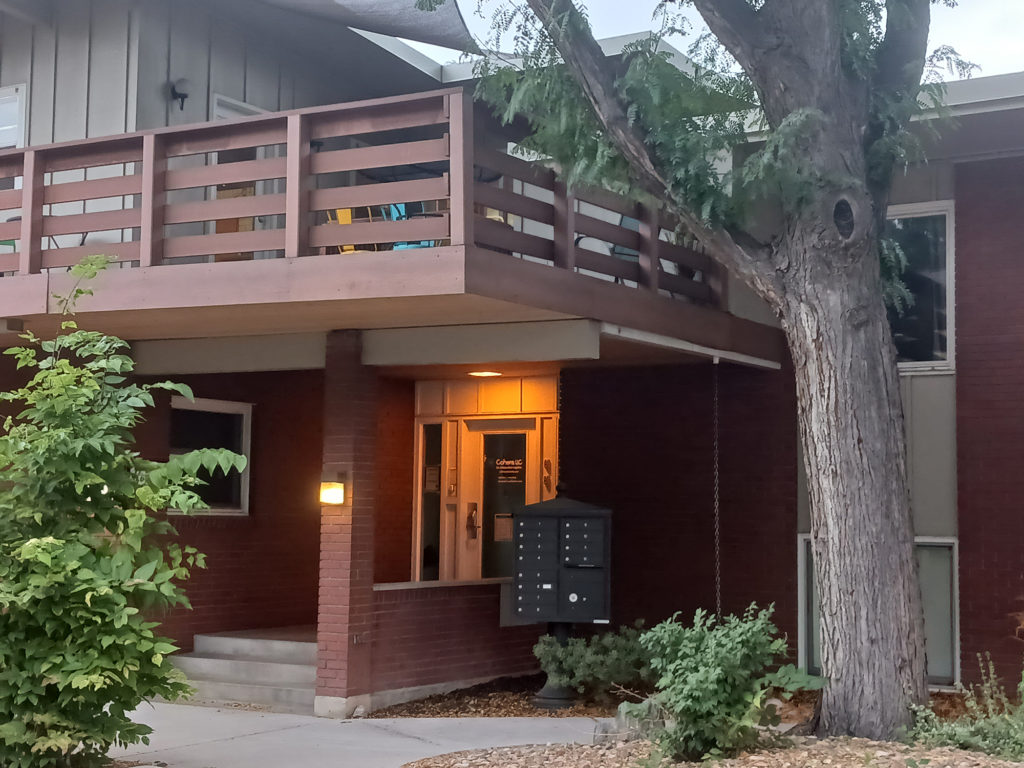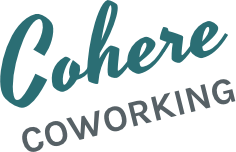
The building where Cohere Coworking is currently housed was built in 1964, Fort Collins’ centennial year and the same year that the nearby Park Lane Towers were erected. It’s a wonderful midcentury building, an architectural era that our founder and founder of Hairpin Homes, Angel Kwiatkowski, is particularly drawn to. The butterfly roof is characteristic of the era, and one of only two left in Fort Collins.
Interested in checking out that iconic 1960s butterfly roof while also being wildly productive? Book a tour of Cohere Coworking today!
Its first resident was a prominent optometrist in the area, and president of the Colorado Optometric Association, Dr. Lynn Miller. Dr. Miller and his wife occupied the property throughout the 60s, at different times sharing the space with another optometrist and a beauty salon, as well as hosting a reading services center, book review groups, and documentary films. Since then, it has provided space for many different companies, including real estate agents, creative crafting classes, a marketing company, and of course, a coworking community.
One of the key values of coworking is sustainability, a value that can often be seen in the buildings we choose to operate out of. Vintage optometrist’s offices aren’t the only venues that coworking communities occupy, however. Here are a few other coworking studios that have taken up residence in some original spaces.
U.S. Coworking Spaces
The Coven
The Coven, a coworking space designed for women and non-binary individuals in St. Paul Minnesota, is located in a brick-clad Victorian structure known as Blair Flats. Originally a residential building designed in 1887, the building was decorated with in dark Victorian ambiance. The Coven transformed the space into a bright, inviting space by bringing in more light while intertwining original art and design elements to anchor the historic feel of the structure.
Workspace Collective
Workspace Collective, a coworking community in Ocala, FL, chose a historic home built in 1891 to house their enterprise. The building was lovingly restored and renovated, preserving the historic feel, while also transforming it into an open and inspiring space that includes both group areas and private conference rooms and offices, while leaving many of the original features, such as the ornately carved wooden fireplace in the front room, intact.
NeueHouse
NeueHouse, a large coworking community that spans several cities, has transformed several historic landmarks into coworking spaces. In Los Angeles, they occupy both the Bradbury Building, an architectural masterpiece built in 1893, and the original CBS Studios, where legends such as Lucille Ball, the Beach Boys, and Orson Welles performed. Their Madison Square offices, located in the iconic Flatiron District of New York City, were previously occupied by the well-known 1930s Manhattan auction house, Tepper Galleries.
Guild Row
Guild Row, established during the pandemic of 2020, is housed in a huge old factory warehouse in Chicago that hails from the 1930s. The space is built around a large open air courtyard, and offers both traditional and non-traditional workspaces. The founders, who met through the Harvard School of Design, developed the space to cater to makers as well as entrepreneurs, incorporating things like a tool lending library, a commercial kitchen, and a wood shop into the design.
Work Hive
Work Hive was established in 2012 in the heart of downtown Salt Lake City, Utah, and when they decided to expand earlier this year, they set their sights on a building with a slightly different ambiance than their first. Their new offices, which are on the verge of being ready for members, will be located in the historic Hyrum Jensen mansion, a sprawling 8,000-square-foot home originally built over a hundred years ago, in 1911.
International Coworking Spaces
Crew Collective & Café
If you are looking for a grand, opulent space to work in, you need look no further than The Crew Collective & Café in Montreal, Canada. Housed in a former Royal Bank of Canada built in the 1920s, this enormous space incorporates group working areas, conference rooms, event areas, and private offices for members. It still retains its luxurious but welcoming atmosphere, however, from the original marble mosaic floors to the tellers’ stations, still outfitted with the original brass accessories.
La Vaca Coworking
This unique coworking space in Barcelona, Spain offers its members, or “Vaqueros” desks, meeting spaces, and community events in an unusual venue, a former 1950s dairy bar. They’ve incorporated the chill vibe of the original dairy bar into their workspace, including a self-service cafeteria, comfy seats, and a rec room where you can try your hand at ping-pong or billiards.
Fosbury & Sons
Fosbury & Sons is a fairly large coworking company with several locations in Belgium and the Netherlands. Their location in Amsterdam, a 175-year-old building in the heart of the city, has a particularly interesting history. Prior to becoming a coworking space, this elegant building with an Italian palazzo vibe and parquet floors was the Prinsengracht Hospital, which was opened in the center of the city to help combat a cholera outbreak in the early 1850s. The center, either as a hospital or clinic, treated patients from its opening in 1857 until it closed its doors in 2015.
Learn more about how to live sustainably in Fort Collins! Where to Go No-Waste in NOCO.
These few spaces are just a small sampling of the many historic buildings that coworking communities have transformed into thriving and productive work hubs. Coworking spaces can thrive anywhere, including historic homes, cathedrals, and converted bus stations. In converting these old and often abandoned buildings into new, vibrant coworking communities, we honor the core value of sustainability.
Penny Leigh Sebring is a Cohere member, experienced freelance writer, neophyte speculative fiction author, and gatherer of information and imaginary friends.

